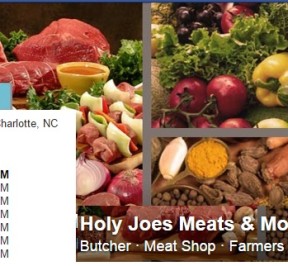Home Page › News › Why is it important to make lean or low-fat choices from the Protein Foods Group?

Jan 14
Why is it important to make lean or low-fat choices from the Protein Foods Group?
Source: Choosemyplate.gov
Foods in the meat, poultry, fish, eggs, nuts, and seed group provide nutrients that are vital for health and maintenance of your body. However, choosing foods from this group that are high in saturated fat and cholesterol may have health implications.
The chart below lists specific amounts that count as 1 ounce equivalent in the Protein Foods Group towards your daily recommended intake:
| Amount that counts as 1 ounce equivalent in the Protein Foods Group | Common portions and ounce equivalents | |
|---|---|---|
| Meats | 1 ounce cooked lean beef
1 ounce cooked lean pork or ham |
1 small steak (eye of round, filet) = 3/12 to 4 ounce equivalents
1 small lean hamburger = 2 to 3 ounce equivalents |
| Poultry | 1 ounce cooked chicken or turkey, without skin
1 sandwich slice of turkey (4 1/2 x 2 1/2 x 1/8″) |
1 small chicken breast half = 3 ounce equivalents
1/2 Cornish game hen = 4 ounce equivalents |
| Seafood | 1 ounce cooked fish or shell fish | 1 can of tuna, drained = 3 to 4 ounce equivalents 1 salmon steak = 4 to 6 ounce equivalents 1 small trout = 3 ounce equivalents |
| Eggs | 1 egg | 3 egg whites = 2 ounce equivalents 3 egg yolks = 1 ounce equivalent |
| Nuts and seeds | 1/2 ounce of nuts (12 almonds, 24 pistachios, 7 walnut halves) 1/2 ounce of seeds (pumpkin, sunflower, or squash seeds, hulled, roasted) 1 Tablespoon of peanut butter or almond butter |
1 ounce of nuts of seeds = 2 ounce equivalents |
| Beans and peas | 1/4 cup of cooked beans (such as black, kidney, pinto, or white beans) 1/4 cup of cooked peas (such as chickpeas, cowpeas, lentils, or split peas) 1/4 cup of baked beans, refried beans1/4 cup (about 2 ounces) of tofu 1 ox. tempeh, cooked 1/4 cup roasted soybeans 1 falafel patty (2 1/4″, 4 oz) 2 Tablespoons hummus |
1 cup split pea soup = 2 ounce equivalents 1 cup lentil soup = 2 ounce equivalents 1 cup bean soup = 2 ounce equivalents1 soy or bean burger patty = 2 ounce equivalents |
Nutrients
- Diets that are high in saturated fats raise “bad” cholesterol levels in the blood. The “bad” cholesterol is called LDL (low-density lipoprotein) cholesterol. High LDL cholesterol, in turn, increases the risk for coronary heart disease. Some food choices in this group are high in saturated fat. These include fatty cuts of beef, pork, and lamb; regular (75% to 85% lean) ground beef; regular sausages, hot dogs, and bacon; some luncheon meats such as regular bologna and salami; and some poultry such as duck. To help keep blood cholesterol levels healthy, limit the amount of these foods you eat.
- Diets that are high in cholesterol can raise LDL cholesterol levels in the blood. Cholesterol is only found in foods from animal sources. Some foods from this group are high in cholesterol. These include egg yolks (egg whites are cholesterol-free) and organ meats such as liver and giblets. To help keep blood cholesterol levels healthy, limit the amount of these foods you eat.
- A high intake of fats makes it difficult to avoid consuming more calories than are needed.
Why is it important to eat 8 ounces of seafood per week?
- Seafood contains a range of nutrients, notably the omega-3 fatty acids, EPA and DHA. Eating about 8 ounces per week of a variety of seafood contributes to the prevention of heart disease. Smaller amounts of seafood are recommended for young children.
- Seafood varieties that are commonly consumed in the United States that are higher in EPA and DHA and lower in mercury include salmon, anchovies, herring, sardines, Pacific oysters, trout, and Atlantic and Pacific mackerel (not king mackerel, which is high in mercury). The health benefits from consuming seafood outweigh the health risk associated with mercury, a heavy metal found in seafood in varying levels.
Health benefits
- Meat, poultry, fish, dry beans and peas, eggs, nuts, and seeds supply many nutrients. These include protein, B vitamins (niacin, thiamin, riboflavin, and B6), vitamin E, iron, zinc, and magnesium.
- Proteins function as building blocks for bones, muscles, cartilage, skin, and blood. They are also building blocks for enzymes, hormones, and vitamins. Proteins are one of three nutrients that provide calories (the others are fat and carbohydrates).
- B vitamins found in this food group serve a variety of functions in the body. They help the body release energy, play a vital role in the function of the nervous system, aid in the formation of red blood cells, and help build tissues.
- Iron is used to carry oxygen in the blood. Many teenage girls and women in their child-bearing years have iron-deficiency anemia. They should eat foods high in heme-iron (meats) or eat other non-heme iron containing foods along with a food rich in vitamin C, which can improve absorption of non-heme iron.
- Magnesium is used in building bones and in releasing energy from muscles.
- Zinc is necessary for biochemical reactions and helps the immune system function properly.
- EPA and DHA are omega-3 fatty acids found in varying amounts in seafood. Eating 8 ounces per week of seafood may help reduce the risk for heart disease.
What are the benefits of eating nuts and seeds?
- Eating peanuts and certain tree nuts (i.e., walnuts, almonds, and pistachios) may reduce the risk of heart disease when consumed as part of a diet that is nutritionally adequate and within calorie needs. Because nuts and seeds are high in calories, eat them in small portions and use them to replace other protein foods, like some meat or poultry, rather than adding them to what you already eat. In addition, choose unsalted nuts and seeds to help reduce sodium intakes.
– See more at: http://www.choosemyplate.gov/protein-foods-nutrients-health#sthash.TKlTojho.dpuf





